St. Norbert Abbey
St. Norbert Abbey is a Roman Catholic monastery of Canons Regular of Premontre, located in De Pere, Wisconsin. The Abbey is named after Saint Norbert of Xanten (c. 1180-1134), the founder of the order, after who, members are known as, "Norbertines". St. Norbert Abbey was established in 1898 by Norbertines from Berne Abbey in the Netherlands. St. Norbert's is the oldest religious community of its kind the United States, serving as the Mother Canonry to Norbertines across North America.
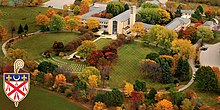
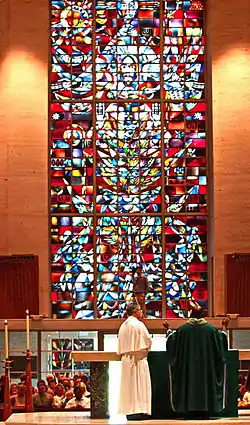 Interior view of the church of St. Norbert Abbey, facing the Great West Window | |
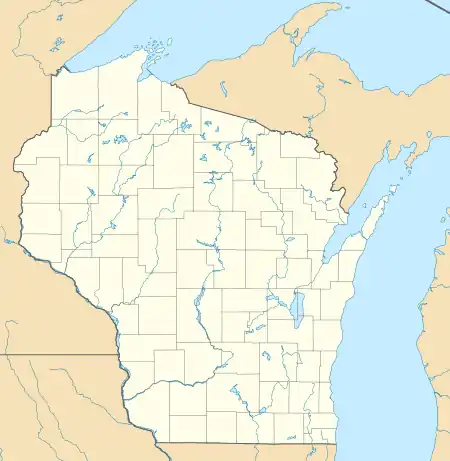 Location within Wisconsin | |
| Monastery information | |
|---|---|
| Order | Order of Premontre (O.Praem.) |
| Established | 1898[1] |
| Mother house | Berne Abbey, Heeswijk, Netherlands (founded 1134) |
| Diocese | Roman Catholic Diocese of Green Bay |
| People | |
| Founder(s) | Fr. Bernard H. Pennings, O. Praem |
| Abbot | Rt. Rev. Dane J. Radecki, O. Praem. |
| Prior | Fr. Bradley Vanden Branden, O. Praem. |
| Site | |
| Location | De Pere, Wisconsin, USA |
| Coordinates | 44.457808°N 88.045142°W |
| Public access | Yes |
| Website | www |
The Abbey is situated on 160 acres (0.65 km2) of land east of the Fox River,[2] south of Green Bay, Wisconsin, within the Roman Catholic Diocese of Green Bay.[2]
The members of the community combine a monastic-style life with the active ministry of ordained priests. Priests and Brothers of the Abbey serve in parish churches, at parochial schools and at St. Norbert College, whose founder, Bernard Pennings, was the First Abbot the community.
History

Norbert of Xanten founded the Norbertines [3] Christmas Day, 1121 in Prémontré, France.[4] The son of a wealthy landholder, Norbert was given to life as a Canon (a minor cleric, as Norbert wasn't yet a Priest) of the Collegiate Church in Xanten, Germany, where he is said to have been unfocused and driven by things other than religious life.
Canons of the Church were required to spend time in choir each day, singing several hours according to the various liturgies prescribed by the Catholic Church. Rather than spending the hours in Church, Norbert would go on adventures and hunts, until his conversion experience in 1112, when he become totally committed to the Christian Faith.
.jpg.webp)
Norbert became a Priest in 1115 and devoted his life to the reform of the Canons under a rule of life established by St. Augustine of Hippo, who is counted with Norbert as a Father of the Premonstratensian Order, which Norbert founded to support his ideal for reform of the Church. In Norbert's lifetime, his fledgling order spread from Ireland to the Holy Land. Wherever he went, people with a zeal for the Church supported his efforts.
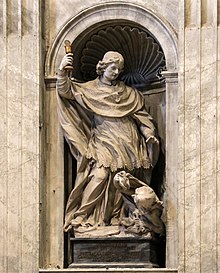
In 1125, Norbert went to Antwerp, preaching in opposition to Tanchelm, whose teachings the Catholic Church opposed. The success of Norbert's mission in Antwerp and across the Low Countries, led to the foundation of Norbertine Abbeys in the Netherlands and Belgium. Among these religious communities was Berne Abbey, located in North Brabant, the Netherlands. Berne was established in 1134, the same year as Norbert's death.
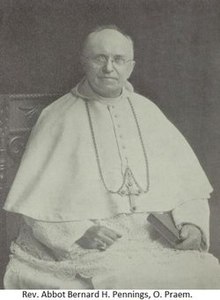
Centuries later, Norbertine Priests led by Bernard Pennings, came from Berne and established an Abbey in Wisconsin. Pennings established a network of Norbertine schools and Parishes, establishing St. Norbert College as a seminary, then a college of business. In 1898, St. Joseph Parish, in West De Pere, Wisconsin became affiliated with the Norbetines and served as the Abbey Church for decades.[2]
In the 1950's, a growing Premonstratensian community at the Abbey had outgrown the available space within the original buildings. Land was donated in 1954, for the purpose relocating the monastery, and building a new Abbey Church. June 9, 1956 marked the beginning of construction and by February 1, 1959, the community inhabited their new headquarters.[5]
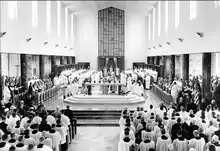
Liturgy & Architecture
The Norbertine Order is known for the solemnity of its liturgies, reflecting Norbert's devotion to the Eucharist. Members of the community wear the Order's traditional white habit in Church. The Community chants the daily office from its own liturgical books in English each day, with Marian hymns chanted in Latin.
The Abbey is well known for the chanting of the hours, its highly symbolic; yet modern stained glass, and its excellent pipe organ.
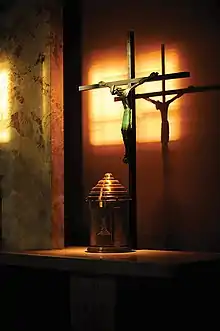
The Abbey's Design

St. Norbert's was completed in the years before the Second Vatican Council by the Second Abbot, Sylvester Michael Killeen, O. Praem. (1905-2000). It reflects the Liturgical Movement, preceding the Council. The Abbey Church is built in the basilica style, with a well appointed nave and a long choir. Its use of travertine, and polished marble of deep green or white provide a sense of permanence and grandeur to the austere design.
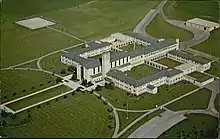
The new St. Norbert Abbey building project was designed by a Wisconsin architectural firm; Berners, Schober, and Kilp. Modeled after centuries-old European Norbertine and Cistercian monasteries, the materials utilized in constructing it were selected for both their beauty and permanence. Limestone from Fond du Lac, Wisconsin, and Indiana, as well as slate from Pennsylvania and Vermont were used in construction. The building's design physically represents the history of the Norbertine Order, with a "spine stretching from west to east", at heart of the structure.[6]
The design reflects the Cistercian ideals of Norbert of Xanten's friend, St. Bernard of Clairvaux, whose Cistercians are a similar movement to Norbert's Premonstratensians.
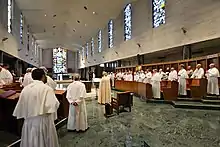
St. Bernard wrote against the most excessive ornamentation of the Churches in his time, saying, "...in the cloister, in the sight of the reading monks, what is the point of such ridiculous monstrosity, the strange kind of shapely shapelessness? Why these unsightly monkeys, why these fierce lions, why the monstrous centaurs, why semi-humans, why spotted tigers, why fighting soldiers, why trumpeting huntsmen? …In short there is such a variety and such a diversity of strange shapes everywhere that we may prefer to read the marbles rather than the books."
The Abbey's architecture combines a simplicity of form and line , with a grandiose scale and rich materials. It is evocative of St. Bernard's ideals, which deeply influenced the thinking of his friend Norbert.
The Pipe Organ
The Abby organ is a landmark instrument by Canadian Builder Casavant Pipe Organs. In addition to its size and quality, it is the first instrument designed by tonal director Lawrence Phelps, and is somewhat atypical of his work.
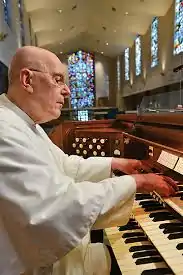
The Abbey uses the organ to accompany their liturgies almost every day of the year, except for days like Good Friday, when liturgical tradition precludes the uses of the pipe organ.
The Crypt
The Abbey Crypt is home to the graves of the first two Abbots of St. Norbert Abbey, featuring a display of treasures used in their tenure.
It holds a historic statue of St. Joseph, which survived a fire at the original Abbey Church. A series of Altars are in a side chapel, for multiple Priests to say Mass at the same time. They include individual shrines with altars to various saints:
- Altar of Saints Peter and Paul
- Altar of St. Thomas Aquinas
- Altar of St. Luke
- Altar of St. Herman Joseph
- Altar of St. Mark
- Altar of St. Theresa of the Child Jesus
- Altar of St. John
- Altar of Saint Patrick
- Altar of St. Siard
- Altar of St. Augustine
- Altar of St. Pius X
- Altar of St. Sylvester
- Altar of Saint Monica
- Altar of St. Matthew[7]
The Abbey's bells
The set of six bells at the St. Norbert Abbey were cast in the Netherlands at the Bell-Foundry of Petit and Fritsen in Aarle-Rixtel and hung in the Abbey Church towero on July 2, 1958. Shortly before installation, they "were consecrated by His Excellency, The Most Reverend Stanislaus Vincent Bona, D.D., Bishop of the Diocese of Green Bay ... Each bell has an appropriate name, a fitting inscription, and bears the crest of the person in whose memory it is dedicated as well as the shield of St. Norbert Abbey."[8]
On June 16, 2009, the Norbertines celebrated the 50th anniversary of the dedication of this new St. Norbert Abbey. In 2020, the Abbey celebrates the 900th Anniversary of the Order.
Abbey Apostolates
Clergy from the Abbey serve in the Dioceses of Green Bay and Chicago. The Abbot is the Keeper of the National Shrine of St. Joseph, located on the campus of St. Norbert College. Priests of the Abbey have served as the Pastor of the Shrine for more than a century
Priests of the Abbey oversee local Parishes and Catholic Schools, and maintain charitable programs in Chicago and Green Bay.
National Shrine of St. Joseph
The National Shrine of St. Joseph is the Parish Church of St. Norbert College, and the home to the Crowned Statue of Joseph and the Child Jesus. The statue was moved to the Abbey from its original location, then returned to the Shrine in 2015.[9]
%252C_De_Pere%252C_Wisconsin.png.webp)
In 1888, Father Joseph Durin began work to have the statue of Saint Joseph crowned and declared a national shrine. Father Durin’s efforts were rewarded, and in 1892 Pope Leo XIII officially recognized the statue as a National Shrine.[9]
Sebastian Gebhard Messmer, Bishop of Green Bay, presided over the coronation of the statue. St. Joseph was presented with a flat (mural) crown, while the Christ Child in his arms was crowned by their Canonical crowns granted by Pope Leo XIII in 1891.[10]
The Shrine came into care of St. Norbert Abbey in 1969 and was moved to the Abbey for some years.[9] It was moved back to its original location at St. Joseph Church, St. Norbert College in the middle of 2015.[9]
A weekly novena to St. Joseph, started by Father Durin in 1888 and continues with rare interruptions, Wednesdays at 12:30pm.
Abbots of St. Norbert Abbey
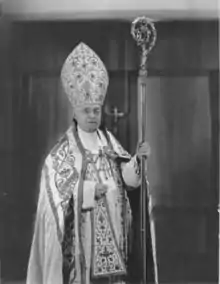
- 1925-1955 — Abbot Bernard H. Pennings, O. Praem.
- 1955-1970 — Abbot Sylvester M. Killeen, O. Praem.
- 1970-1982 — Abbot Jerome G. Tremel,[11] O. Praem.
- 1982-1992 — Abbot Benjamin T. Mackin,[11] O. Praem.
- 1992-2003 — Abbot E. Thomas De Wane, O. Praem.
- 2003-2018 — Abbot Gary J. Neville, O. Praem.
- 2018–present - Abbot Dane J. Radecki, O. Praem.
Daughter Houses
- Our Lady of Daylesford Abbey, Paoli, Pennsylvania
- Santa María de la Vid Abbey, Albuquerque, New Mexico
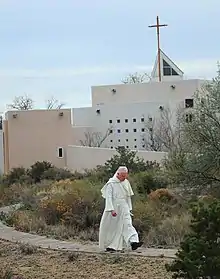 A Premonstratensian Canon at the Abbey of Santa Maria De La Vid
A Premonstratensian Canon at the Abbey of Santa Maria De La Vid
Mission of St. Norbert Abbey
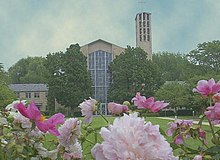
Christ and the Church call us to live as a community of one mind and one heart on the way to God, in a manner consistent with the Gospel, the spirit of our founders, and the constitutions of our Order.
God summons us to hear the Good News of salvation and to proclaim the kingdom of freedom, love, justice, and peace.
Jesus the Lord challenges us to shape an ecclesial spirituality expressed in liturgical celebration, personal prayer, and a journey of faith to the kingdom.
The Spirit lays a claim on us to engage in a variety of ministries to one another, to the People of God, and to the world at large.
God urges us to face the future with openness, hope, and courage.[4]

Controversies
In July 2019 Abbot Dane Radecki published a list of 22 Norbertines with credible accusations of sexual abuse against minors. This followed a comprehensive inquiry of the Abbey by an independent firm specializing the investigation and prevention of child sexual abuse by institutional leaders. Between December 2020 and February 2021, the Green Bay Press-Gazette published a series of stories about allegations of abuse against a listed Priest. The accuser made a series of accusations, the first coming in 2002 to civil authorities, then again 2018 and 2019 to the Press-Gazette, who did not publish the story until a year after the accuser's suicide. The report stated the Abbey sent $420,000 in pastoral support to the accuser, in addition to funding his medical and psychiatric care from 2009-2019.
The report indicates that in 2018, when the incumbent Abbot informed the accuser payments might stop, the accuser leveled additional allegations.
These new allegations, "...prompted the Norbertines to contact Praesidium, a risk management firm focused on sexual abuse, and request an investigation. The Texas-based group had worked with dozens of organizations and Catholic dioceses and would later help the order compile its list of priests with credible abuse allegations against them."[12]
The report noted that Praesidium, who helped corroborate the allegations surrounding the USA Gymnastics sex abuse scandal , deemed the allegations by the accuser, "not credible" and payments were stopped.
Reporter Haylee Bemiller said, "Praesidium around that time noted the 'unusual nature' of Lindstrom’s payments, and both the firm and Order's legal counsel recommended they should end."[12]
In January 2021, the Press-Gazette published a petition calling for the resignation of the current Abbot, a priest and a nun. The Abbot responded by apologizing for sad events in the past.[12]
References
- St. Norbert Abbey 1959, p. 101
- Geudens, 'St. Norbert'
- St. Norbert Abbey 2009, 'Who We Are'
- St. Norbert Abbey 1959, p. 113
- Rossey, Stephen 2009, p. 5
- St. Norbert Abbey (1959). The Haven of My Salvation: A Commemorative Volume on the Occasion of the Dedication of St. Norbert Abbey, De Pere, Wisconsin, June 18, 1959. De Pere, Wisconsin, pp. 34-36.
- St. Norbert Abbey 1959, p. 21-23
- McManon, Todd (September 16, 2015). "Homecoming for National Shrine of St. Joseph". Green Bay Press Gazette. Retrieved November 12, 2016.
- "Photos of the Shrine". Shrineofsaintjoseph.org. Retrieved 2016-03-30.
- St. Norbert Abbey 1993, p. 87
- BeMiller, Haley. "A Notre Dame Academy graduate alleged abuse by priests, then died by suicide. Over 400 alumni demand answers". Green Bay Press-Gazette.
Sources
- Geudens, F. M., "St. Norbert", The Catholic Encyclopedia, New York: Robert Appleton Company, retrieved 2009-07-05
- National Shrine of St. Joseph (2008–2009), A Ministry of Devotion to St. Joseph, retrieved 2009-07-02
- Rossey, Stephen, O.Praem. (Spring 2009), "The Abbey by Design", Abbey Magazine, 1 (1): 5, archived from the original on 2012-07-30, retrieved 2019-05-09
- St. Norbert Abbey (2009), Our History, archived from the original on 2008-05-09, retrieved 2009-07-02
- St. Norbert Abbey (2009), Who We Are, archived from the original on 2008-05-11, retrieved 2009-07-02
- St. Norbert Abbey (1993), With the grace of God: on the occasion of the 100th anniversary of the origin of the De Pere Norbertines, Alt Publishing: Green Bay, Wisconsin, p. 87
